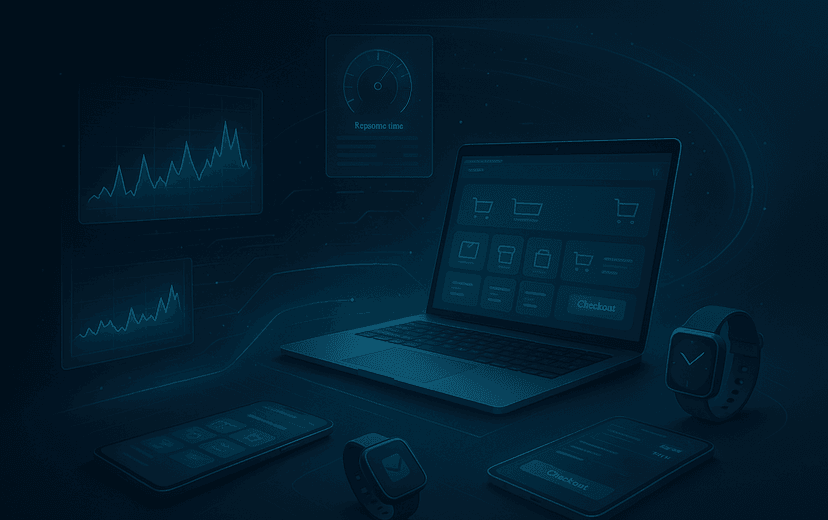In e-commerce, speed isn’t just a technical metric — it’s a direct revenue driver. Studies show that a 1-second delay in page load time can reduce conversions by up to 7%, and during high-traffic events like Black Friday or festive sales, that percentage translates into massive revenue losses.
Your online store must be capable of handling thousands of concurrent users, executing rapid database queries, and processing high-volume payments — all without a hitch. Even the smallest slowdown in checkout or search can result in abandoned carts and lost customers.
Performance and load testing ensure your e-commerce platform stays fast, stable, and reliable under any traffic condition. At Testriq QA Lab, we simulate real-world user activity, identify bottlenecks, and provide optimization strategies that keep your store running at peak performance — even during the busiest sales seasons.
Why Performance Testing Matters for E-Commerce
Performance testing directly impacts revenue, brand reputation, and customer loyalty. The benefits go far beyond just speed:
- Customer Retention – A smooth, fast checkout process reduces cart abandonment.
- Search Rankings – Google rewards sites that load quickly, improving SEO visibility.
- Revenue Protection – Avoid losing millions due to downtime during campaigns.
- Brand Trust – Consistent, reliable performance builds confidence in your store.
Core Types of E-Commerce Performance Testing
| Test Type | Purpose | E-Commerce Example |
| Load Testing | Validates performance under expected traffic. | Simulating a normal weekday shopping load. |
| Stress Testing | Tests beyond capacity to find breaking points. | Black Friday or Diwali mega-sale surge. |
| Spike Testing | Checks sudden traffic jumps. | Limited-time flash sales. |
| Endurance Testing | Assesses long-term stability under sustained usage. | Weekend or week-long festival sales. |
| Scalability Testing | Determines how the site handles growing user loads. | Expanding to new regions or markets. |
New High-Impact Focus Areas
1. Checkout Process Speed Optimization
The checkout page is where sales happen — or are lost. Our testing ensures:
- Payment gateway responses within 3 seconds.
- Minimal page reloads with asynchronous updates.
- Reduced API latency for inventory verification.
2. Database Query Performance
Even a high-speed front-end can be slowed by inefficient queries:
- Optimize queries for product searches & filtering.
- Implement caching for frequently accessed data.
- Use proper indexing to improve order processing times.
3. Mobile Performance Validation
Over 70% of e-commerce traffic comes from mobile devices:
- Lighthouse audits for mobile scoring.
- Network throttling tests for 3G, 4G, and 5G.
- Adaptive image optimization for faster loading.
Best Practices for E-Commerce Load Testing
- Simulate realistic user flows (browse, search, add to cart, checkout).
- Test third-party integrations like shipping APIs and payment gateways.
- Use cloud-based tools (BlazeMeter, LoadRunner Cloud) for scalable simulations.
- Continuously monitor KPIs — page load time, transaction speed, error rates.
Common Bottlenecks & Fixes
| Bottleneck | Impact | Solution |
| Slow database joins | Delayed product listings and checkout lag. | Query indexing, caching. |
| Unoptimized images | Increased product page load times. | WebP format, lazy loading. |
| Limited server capacity | Site crashes during heavy load. | Auto-scaling cloud infrastructure. |
| API latency | Checkout stalls, failed transactions. | Optimize endpoints, enable CDN caching. |
Integrating Performance Testing into Your QA Process
Performance testing shouldn’t be a once-a-year activity before a big sale. It should be part of your ongoing QA strategy:
- Run load tests after every major update.
- Integrate into CI/CD pipelines for continuous validation.
- Use Real User Monitoring (RUM) to analyze live performance.
Advanced E-Commerce Performance Testing Topics
1. CDN (Content Delivery Network) Optimization
Using CDNs like Cloudflare or Akamai can drastically reduce load times by delivering content from servers closer to your customers.
2. AI-Powered Load Testing Predictions
Machine learning can predict peak traffic scenarios and simulate them before they happen.
3. Payment Gateway Performance Audits
Testing payment gateways under high loads ensures transaction reliability and security.
FAQs: Performance & Load Testing for E-Commerce
Q1: How often should I run performance tests?
Ideally, before every major sales campaign, after major site updates, and quarterly as part of ongoing QA. Continuous monitoring helps catch performance drops early.
Q2: What’s the difference between load testing and stress testing?
Load testing validates performance under normal traffic, while stress testing pushes the site beyond expected limits to find breaking points.
Q3: Do you test third-party integrations during load testing?
Yes — our simulations include payment gateways, inventory systems, and shipping APIs under load to ensure end-to-end stability.
Q4: Can performance testing improve SEO?
Absolutely. Faster sites lower bounce rates, increase engagement, and boost Google rankings.
Final Thoughts
In e-commerce, performance is profit. A lightning-fast, stable platform builds trust, boosts conversions, and keeps customers coming back. Without regular performance and load testing, you risk losing sales during your most critical moments — peak seasons, flash sales, and viral campaigns.
Investing in performance testing means:
- Confidence during traffic surges.
- Protection from costly downtime.
- Growth readiness as your user base expands.
The truth is simple — your store is only as strong as its ability to perform under pressure. At Testriq QA Lab, we ensure your e-commerce site is not just ready for today’s traffic, but prepared for tomorrow’s growth.
About Jayesh Mistry
Expert in E-commerce testing service with years of experience in software testing and quality assurance.
Found this article helpful?
Share it with your team!
